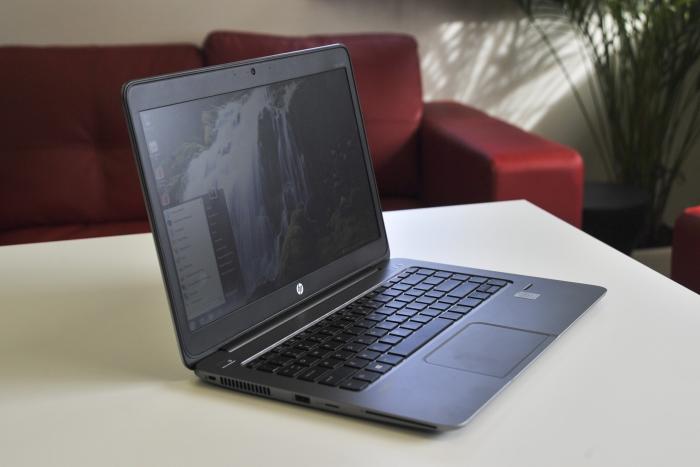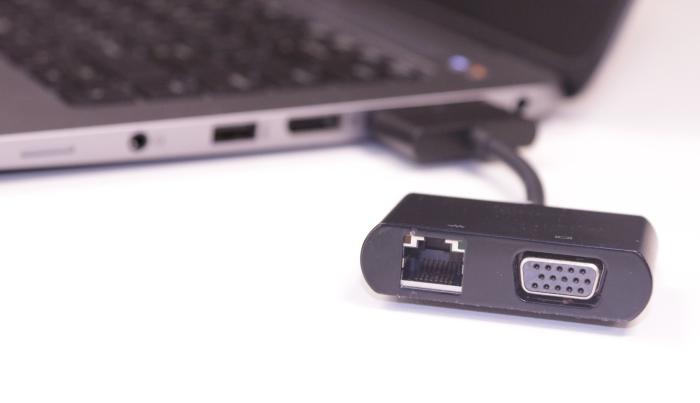
HP EliteBook Folio 1040 G1 (E7N23PA)
A 14in Ultrabook that's designed to appeal to big business
Pros
- Solid construction
- Comfortable keyboard
Cons
- Specs a little low for the price
- ForcePad feels different to a touchpad
- Some 2.4GHz Wi-Fi woes
Bottom Line
HP's business-oriented 14in Ultrabook offers a thin and light solution for enterprises, while maintaining security and management features. It's well built, performs swiftly for the most part, but its cost is high.
-
Price
$ 2,499.00 (AUD)
HP has been on a bit of a roll recently in the land of business laptops, with products such as the ZBook 14 and the EliteBook Revolve 810 G2 being a little different from the norm and catering to power users and hybrid seekers, respectively. Basically, the veteran PC company has come up with some interesting stuff in the business space.
Build quality
The 14in EliteBook Folio 1040 G1 Ultrabook is more of a traditional notebook in terms of looks and processing power, but it distinguishes itself by offering more features that are tuned to the needs of business users.
These features include a durable design, a facility for docking, a vPro chipset, BIOS-level virus protection (it’s called HP Sure Start and it works by identifying modifications to the BIOS image), multiple user authentication methods (Smart Card and fingerprint reader), and built-in 4G connectivity (though it’s optional). Features such as a touchscreen, or even a Full HD screen aren’t standard, but are available as options if needed.
It’s a laptop that has passed MIL-STD 810G testing for ruggedness, which means it should be able to survive accidental drops and spills (within reason — the keyboard has drain holes), as well as a wide temperature range, and it can also operate in dusty environments. HP told us that the internal structure is designed in such a way so that dust entering the chassis is channelled out without hitting the components, but wasn’t forthcoming with any extra details regarding filtering.
The construction of the laptop consists of a unibody aluminium chassis, palmrest, and keyboard tray (with HP making a point that the metal actually frames each key), while the bottom panel is a hard, moulded plastic that’s held to the chassis with star-shaped screws.
User comfort
There’s a fan on the left side that kicks in to cool down the system when the CPU is putting in lots of work. It didn’t get too loud under a full CPU load, and in a typical office environment or boardroom will be virtually inaudible. A little bit warmth can be felt in the area under the fan and heatsink, which might be uncomfortable if you are using the Ultrabook on your lap. That said, if you’re performing processor-intensive tasks, it’s best to leave the Ultrabook on a flat surface so that it can breathe easier.
The laptop feels good to hold and use for long periods of time, despite its slightly larger size of 14in (rather than the 13.3in size of many consumer Ultrabooks), mainly because it’s thin (about 16mm), has a manageable weight (1.52kg), and a Chiclet-style keyboard that's comfortable to hit. The keys are full sized, soft, quiet, responsive, and they have an attractive white backlight with two brightness levels. We had no problems typing on this laptop for long periods of time, though we had to get used to the extra column of keys on the right, which has the Delete key placed above the Home key, rather than the Backspace key.
The touchpad is something different. It's what Synaptics calls a 'ForcePad' rather than a touchpad or ClickPad, and that's because, rather than clicking it, you have to put downward pressure on it to perform a clicking action -- there is no switch. It's an unnatural action that HP has attempted to make more natural by playing a 'clicking' noise through the speakers every time the pad is used for right-clicking or other actions that require force. The trouble is, if you've muted the speakers, you don't hear the clicks. Apart from that rather major quirk, the touchpad behaved as expected and we didn't have any problems controlling the pointer or performing the gestures we're already used to (two-finger scrolling, two-finger taps, and three-finger flicks).

As for the screen, the one on our test model is a 1600x900-resolution panel, but Full HD is available as an option if you need it. The 1600x900 panel has a non-reflective finish, but decent brightness. Its viewing angles aren’t great (it uses TN technology rather than IPS), which means you might have to tilt the screen to see images, videos (especially ones with dark scenes) and colour gradients properly.
Peripheral connections can be made through two USB 3.0 ports, a full-sized DisplayPort, and through the side-mounted docking port. There is a breakout cable that plugs into the docking port to supply a VGA port and an Ethernet port.
Other features around the sides include a headset port, a Smart Card reader, and a microSD card slot. We would prefer a full-sized SD card slot, if only so the laptop could be used to quickly transfer cards from a digital camera. The microSD slot is fine if you want to add a bit more storage to the mix. Note that access to the ports can be controlled through the pre-installed HP security software.



Specs and battery life
In the engine room, the EliteBook Folio 1040 G1 (E7N23PA) has a fourth generation Intel Core i5-4300U CPU, 4GB of RAM, Intel HD graphics, and a 128GB SanDisk solid state drive (SSD). Considering the price of $2499, the configuration is shabby and should give more bang for buck (at least 8GB of RAM and a 256GB SSD), but it's typical of business unit pricing where the focus is mostly on management features and build quality. Nevertheless, the unit performed as expected in our tests, recording 44sec in Blender 3D (rendering), 20min in HandBrake (converting a DVD file to an MP4), and 4265 in 3DMark's Cloud Gate run.
There is a 42 Watt-hour battery inside the unit, and it gives the Folio 1040 an acceptable run time away from a power outlet. In our rundown test, in which we disable power management, enable Wi-Fi, maximise brightness, and loop a video file, the laptop ran for 4hr 45min. How much life you get from it will depend on your usage and settings. During a typical scenario in which we used the notebook for word processing, watching the occasional clip, and doing so with the keyboard backlight on and the screen brightness just under 50 per cent, the battery lasted almost 5.5 hours.
Other things to note about the EliteBook Folio 1040 G1 are a slim power adapter, TPM 1.2, Bluetooth 4.0, a webcam, decent speakers, and dedicated buttons for muting the audio and toggling Wi-Fi. The Wi-Fi is an Intel Dual Band Wireless-AC 7260 adapter, which works very well when you are connected to an 802.11ac router. However, we did notice periodic Internet dropouts when we connected to an 802.11n router on the 2.4GHz band, but we did not get a chance to play around with different drivers since we picked up on the issue late in our review period.
Conclusion
The bottom line for the EliteBook Folio 1040 G1 is that it's an Ultrabook tailored to the enterprise market. It has the build quality, and the management and security features that should appeal to many IT admins, though the price for the basic configuration, and some of the connectivity and input device choices are questionable.
For example, the lack of built-in VGA could be seen as a drawback for some, even though an adapter for it is available (it's another part that can potentially be lost). Also, the ForcePad-style touchpad is a feature that might not be best suited to a business product, mainly because it's not something users are accustomed to. A regular touchpad would be a better fit for the sake of familiarity. Lenovo also made notable changes to the keyboard, touchpad and controls of its ThinkPad X1 Carbon business laptop, which we also questioned.
That said, it's a well built Ultrabook that we enjoyed using on a daily basis, and it should cruise through most daily business computing tasks with ease.
Brand Post

Most Popular Reviews
- 1 Dell U3223QE review: A winning debut for an IPS Black monitor
- 2 HP Spectre x360 16 review: The right 2-in-1 at the wrong time
- 3 Acer K242HYL review: An affordable monitor for any occasion
- 4 GeForce Now review: You bring the games, Nvidia streams the hardware
- 5 Asus ProArt PA279CV monitor review: The go-to for content creators on a budget
Latest News Articles
- Want to go watch the WWDC keynote at Apple Park? Here’s how to apply
- Apple to support ‘passwordless’ iPhone logins on Android phones and PCs
- If you downloaded iOS 9 on an iPhone 4s, you may be entitled to a refund check
- Best wireless headphones
- An intrepid YouTuber made his own 5K Studio Display for just US$600
Resources
Macworld
What's new, plus best mac-related tips
and tricks

Business Centre
The latest business news, reviews, features and whitepapers

Videos
Watch our video news and reviews from around the world

Guides
Comprehensive buying guides, features, and step-by-step articles

PCW Evaluation Team
Pedro Peixoto
Aruba Instant On AP11D

Set up is effortless.
Cate Bacon
Aruba Instant On AP11D

The strength of the Aruba Instant On AP11D is that the design and feature set support the modern, flexible, and mobile way of working.
Dr Prabigya Shiwakoti
Aruba Instant On AP11D

Aruba backs the AP11D up with a two-year warranty and 24/7 phone support.
Tom Pope
Dynabook Portégé X30L-G

Ultimately this laptop has achieved everything I would hope for in a laptop for work, while fitting that into a form factor and weight that is remarkable.
Tom Sellers
MSI P65

This smart laptop was enjoyable to use and great to work on – creating content was super simple.
Lolita Wang
MSI GT76

It really doesn’t get more “gaming laptop” than this.
Featured Content
- Which Lenovo Laptop Should I Buy?
- Every TV in Samsung's 2022 line-up: OLED, Neo QLED and more!
- Top 10 best Android and Apple phones for under $600
- Everything you need to know about Smart TVs
- What's the difference between an Intel Core i3, i5 and i7?
- Laser vs. inkjet printers: which is better?










